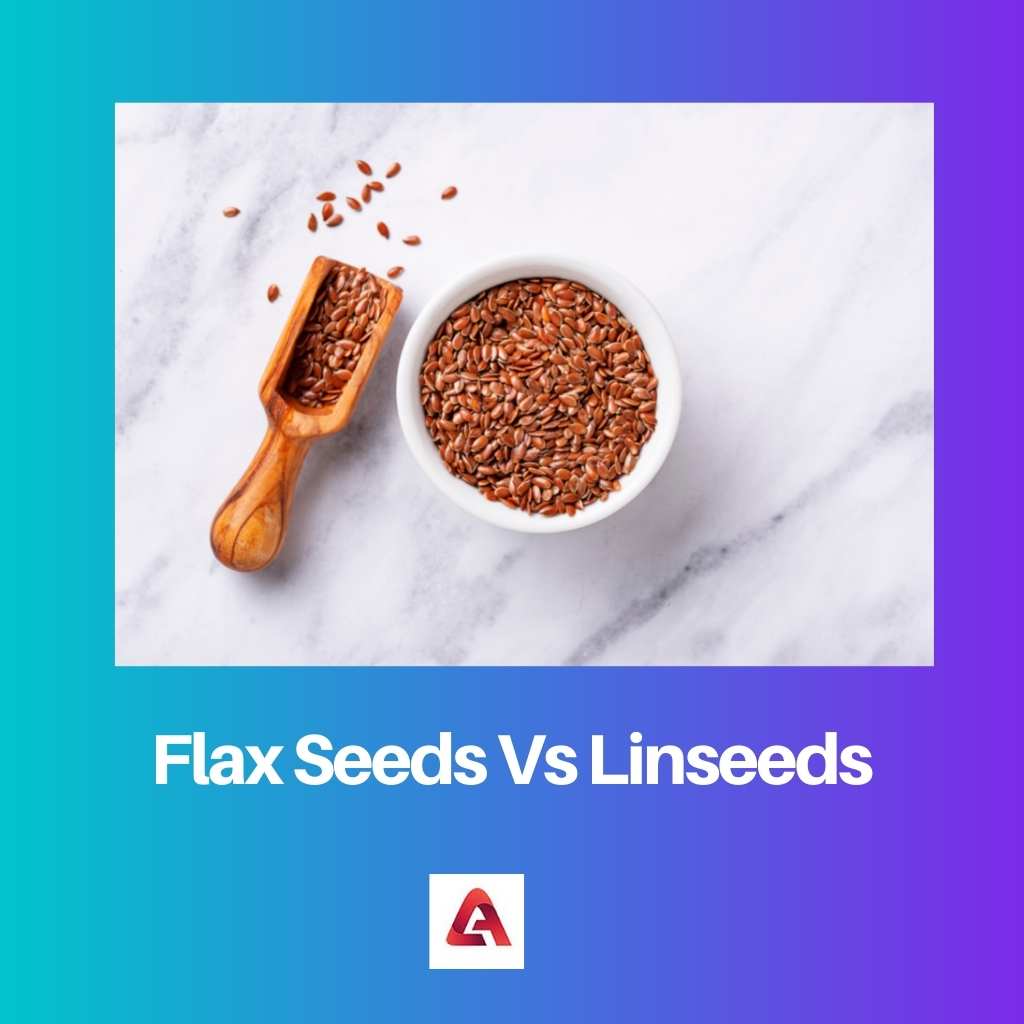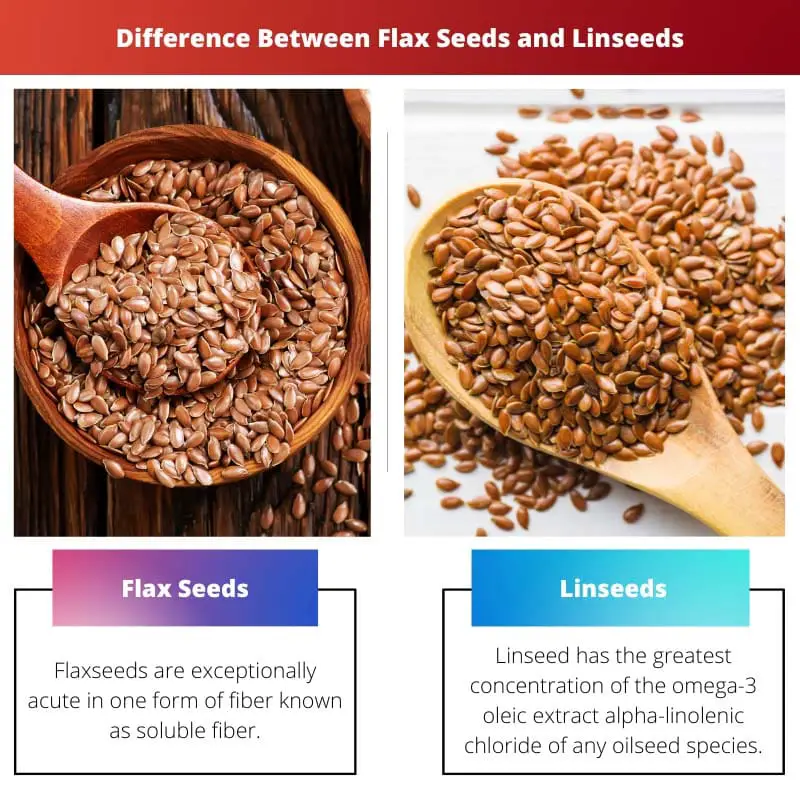Linseeds and flaxseeds are interchangeable when it pertains to purchasing delicacies in South Africa. Dietary, they are identical; the only change is in the plant structure.
The two major English-speaking nations are to blame for the misconception. Both are referred to as flax.
The distinctions appear to be blurring as we gain more impact from the American vocabulary, particularly in the food business.
Key Takeaways
- Flax seeds and linseeds are two names for the same seed, derived from the flax plant, and are rich in nutrients, such as omega-3 fatty acids and fiber.
- Flax seeds can be consumed whole, ground into flax meal, or pressed into oil, providing various health benefits and culinary uses.
- No fundamental differences exist between flax seeds and linseeds, as they are the same product referred to by different names.
Flax Seeds vs Linseeds
Flaxseeds are small, brown, shiny seeds. they are plant-based food that are high in omega-3 fatty acids, fiber, and other nutrients. Linseed is used to produce furniture polish, paints, ink, or clothing. Lineseed can be used to make linseed oil which are used for industrial purposes.

Flaxseeds are exceptionally acute in one form of fiber known as soluble fiber. Soluble fiber, as the name indicates, transforms when it goes into touch with secretions in the belly, transforming into a gel-like material.
It is not digested by the system and does not supply calories, but it attracts and transports bad lipids out of the system. High-fiber menus are connected with lower cholesterol and enhanced heart fitness.
Fiber also helps to maintain consistent blood sugar balances and increases meal satiety.
Linseed has the greatest concentration of the omega-3 oleic extract alpha-linolenic chloride of any oilseed species. It also contains a lot of amino, fiber, and is flavones.
On a dry ratio premise, produced linseed cultivars have 45–50% oil. Linseed’s flexibility is highlighted by its several ends uses as consumer nutrition, animal feed, and commercial purposes.
Linseed is fed to birds and cattle to generate omega-3-enriched yolks and beef, and linseed oil is supplemented to make enriched drinks.
Comparison Table
| Parameters of Comparison | Flax Seeds | Linseeds |
|---|---|---|
| Calories | The calories amount in flaxseed is 150. | The calories amount in linseed is 137. |
| Carbs | The carbs amount in flaxseed is 8 grams. | The carbs amount in linseed is 12 grams. |
| Fiber | The fiber amount in flaxseed is 8 grams. | The fiber amount in linseed is 11 grams. |
| Size | Flaxseed grows higher and has fewer branches. | Linseed is a tiny plant with many tendrils and berries. |
| Uses | Flaxseed has historically been utilized in the production of linen, yarn, and sails. | Linseed is used in the production of oil. |
What is Flax Seeds?
Flaxseeds contain considerable levels of all three important nutrients: protein, fiber, and lipid. According to USDA statistics, one tablespoon has roughly 2 g of protein.
Dietary fiber accounts for only a small portion of the energies in flaxseed, yet it is essential for gastric and cardiovascular health. Flaxseeds can also help keep your heart and brain functioning.
This form of polyunsaturated triglyceride can boost your cholesterol composition by raising amounts of beneficial high-density chylomicrons, which assist your metabolism to eliminate harmful cholesterols.
Flaxseed oil is created by a technique known as cold pressing, which aids in the extraction of the oil from the kernels.
Because this oil is extremely reactive to heat and radiation, it should be preserved in opaque glass containers and maintained in a dark, cold spot, such as a kitchen cupboard.
Flaxseed oil is not ideal for high degree traditional dishes such as burning since some of its components are heat susceptible.
It’s important to note that flaxseed oil seems to have more ALA than crushed flaxseed. Only 7g of powdered flaxseed have 1.6g of ALA, but 14g of flaxseed oil yield approximately 7g.
Nevertheless, flaxseed has a variety of other helpful elements, such as fiber, that are not available in its crude. Chopped flaxseed is the best option for reaping all of this food’s nutritional advantages.

What is Linseeds?
Linseed has several anti-nutritional chemicals that can hurt product output and embryo development in producing chickens.
Mucins, glucosinolates glycosides, thiamine receptors, trypsin blockers, estrogenic effects, and phenolic are a few possibilities.
Natural compounds found in linseed can impair the efficiency of pancreatic hydrolytic protease, reducing protein digestion and nucleic corrosive intake in the small bowel and, eventually, breeding hen supply efficacy.
Linseed includes a high concentration of oxalic acid, which is a poor resource of phosphate for hens due to a lack of spontaneous synthesis of the cellulolytic enzymes, particularly in young fowl.
Phytase aggregates can also decrease the digestibility of many minerals and essential metals, particularly calcium, resulting in poor clam composition in laying hens. Latine is a pancreatic enzyme blocker that inhibits vitamin B6 uptake.
Linseed-based meals can cause vitamin B6 deficient symptoms in chicken, particularly developing pullets. This issue can be resolved by introducing more numerous Health benefits in linseed-based regimens.
The oxidase in linseed is accountable for the synthesis of proton sulfide from glucosinolates compounds.
Linamar has no detrimental repercussions on domesticated animals when taken ingrown linseed has not been heat-treated; nevertheless, it is abundant in juvenile linseed and can contribute to poor growth efficiency if not handled with temperature.

| # | Preview | Product | |
|---|---|---|---|
| 1 |

| Yupik Organic Brown Flax Seeds, 2.2 lb (35.2 oz), Gluten-Free, Non-GMO, Kosher, Vegan, Raw Seeds,... | Check Price on Amazon |
| 2 |

| Biona Organic Linseed Brown 500G | Check Price on Amazon |
Main Differences Between Flax Seeds and Linseeds
- The protein amount in flaxseed is 5 grams. Linseed, on the other hand, the protein amount is 4 grams.
- The fat amount in flaxseed is 12 grams. Linseed, the fat amount is 9 grams.
- The omega 3 fatty acids amount in flaxseed is 6400 mg. linseed, on the other hand, the omega 3 fatty acids amount is 4900 mg.
- The omega 6 fatty acids amount in flaxseed is 1700 mg. Linseed, on the other hand, the omega 6 fatty acids amount is 1600 mg.
- The manganese percentage in flaxseed is 35% of the RDI. Linseed, on the other hand, the manganese percentage is 30% of the RDI.






